Winning a customer is not easy.
It takes time, effort, and investment to win a deal.
For instance, we observed the sales cycle of over 1000 customers in our CRM software and found that it takes anywhere from 10 days to 3 months and more to close a deal.
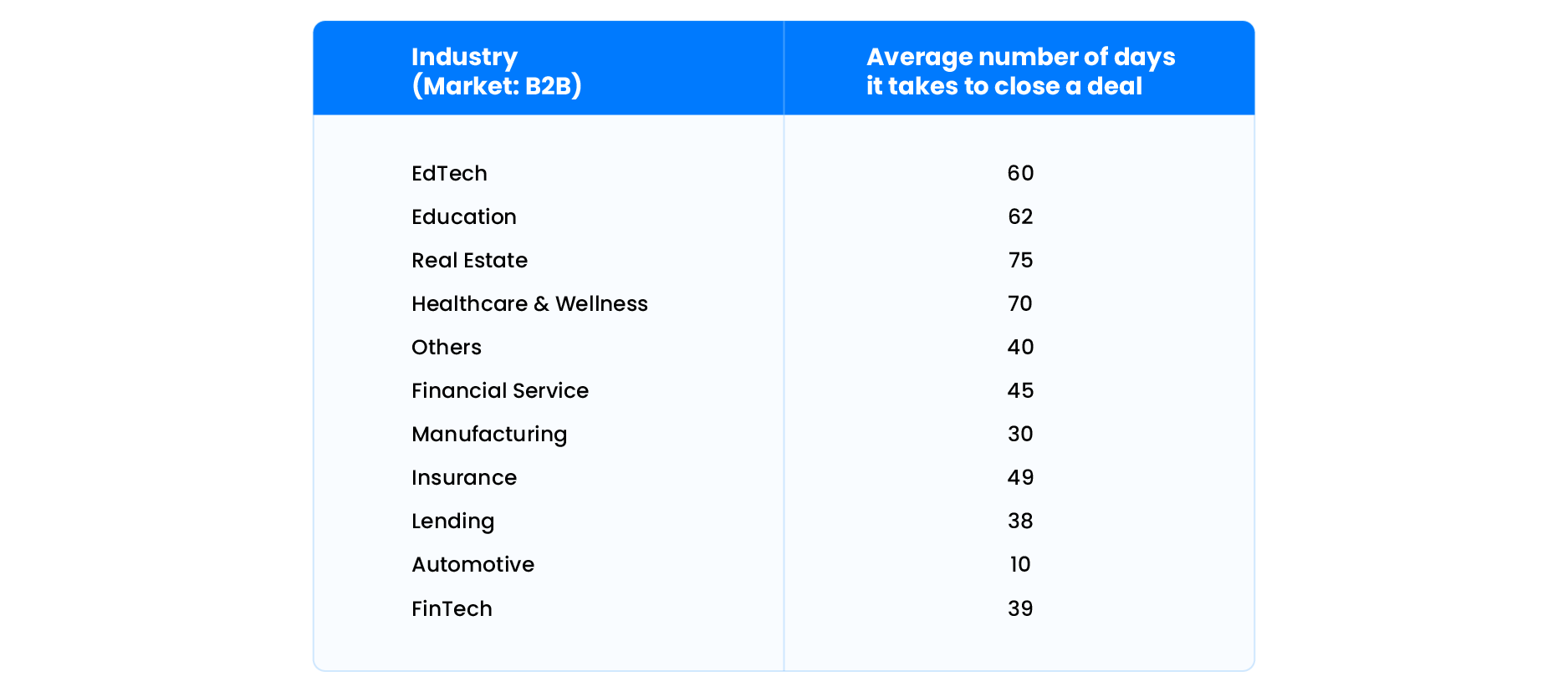
Of course, the sales cycle varies according to the industry, customer segment (B2B or B2C), and ticket size. But, acquiring a customer is not as easy as it may look. So, how can you afford to lose them?
A simple solution to increase retention (and revenues) is customer engagement.
What is Customer Engagement?
Customer engagement is the process of interacting with customers to strengthen their relationships with your brand. The interactions can take place over various channels – from in-store to digital. In fact, digital customer engagement has now become more important than ever.
Since the pandemic, 47% of customers have increased their engagement with brands via digital channels. Moreover, 86% of them want to either maintain or increase digital interactions with businesses. Some of the top emerging channels of customer engagement are:
- Push notifications
- Chatbots and live chats
- Facility to call directly from a webpage or mobile app
- Videos
- In-app messaging
However, it’s not easy for brands to engage with their growing number of customers across several different channels. The result—frustrating experience for customers.
5 Customer Engagement Challenges That Drive Customers Away
Vonage surveyed 5000 consumers from 14 countries and uncovered the gaps in interactions between brands and their customers.
Sadly, these gaps could be costly for brands, as customers are likely to stop doing business with them because of the following engagement challenges.
- Non-availability of customer support options
- Not being able to switch communication channels
- When they have to repeat their query/concern to an agent after explaining the same to the chatbot
- Long wait time to get in touch with a support staff
- When a self-help portal,chatbot or ai shopping assistant couldn’t resolve the issue, and customers don’t find a way to connect to a human agent
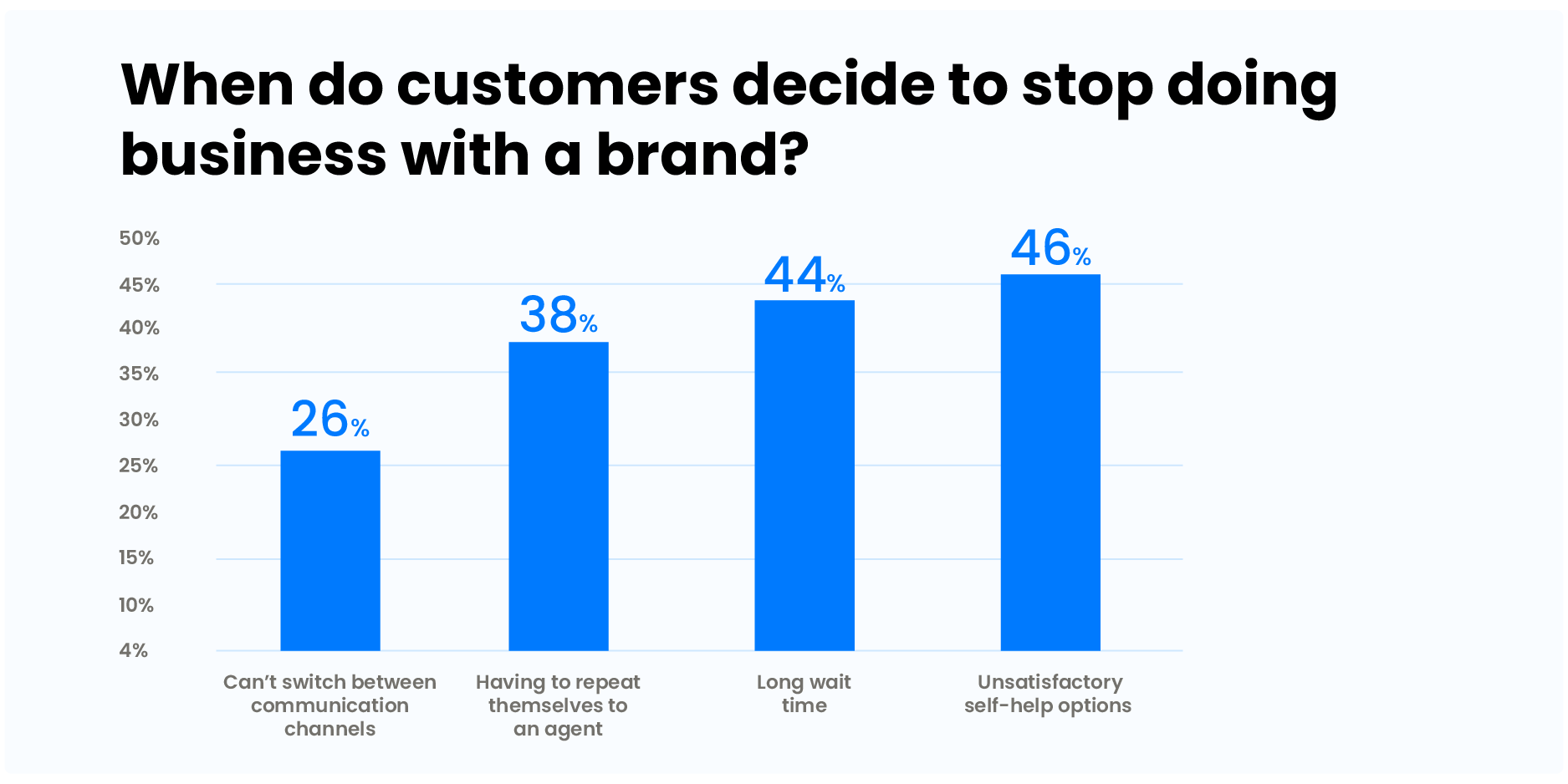
Keeping the customer engaged with your brand keeps them around for longer.
Even if the customer does not actively make purchases from you, they can help market your products and services. Social proof is a powerful marketing technique, and customer engagement helps with that a lot.
Let’s explore this topic further.
Why is Customer Engagement Important?
By engaging with customers, you can foster your relationship with buyers. It can help you in several ways, such as:
- Increase brand loyalty
- Reduce churn rates and improve customer retention
- Leverage opportunities to up-sell and cross-sell
- In some cases, shorten the sales cycle (your customers advocate for your offering)
- Improve customer service metrics
There are several benefits to customer engagement. The one that tops the list is—retention. And there are valid reasons for it.
- Customer retention is almost 5 times less expensive than new customer acquisition.
- A mere 5% increase in customer retention rate may lead to 25-95% higher profits.
So, now you have more reasons to increase customer engagement. Let’s look at the strategies to engage with customers. We’ll also share successful customer engagement campaign examples to help you visualize the effectiveness of those strategies.
12 Super-Effective Customer Engagement Strategies [With Examples!]
1. Create your brand voice
Customers want to engage with a brand with a personality. You can expose your brand personality through your marketing collateral or social media campaigns. For instance, Wendy’s Twitter handle is quite popular for its feisty and humorous attitude. Agree?
Glossier keeps a playful and authentic personality. Women, who are the primary audience of the brand, aim to be the “Glossier Girl.” Having a personality allows your brand to become more relatable.
The key here is to be consistent in your messaging. You may have an audience from different age groups or demographics. Each audience profile has a specific taste. And it is not possible to post as per everyone’s taste. It will only confuse your audience.
So, what’s the solution?
Explore the platform analytics. If your Twitter handle has the maximum number of Gen Z followers, tune your messaging according to them. Similarly, if your Facebook follower demographics comprise mostly Millennials, you can utilize this platform to engage with them.
2. Personalize customer experiences
“If you build a great experience, customers tell each other about that. Word of mouth is very powerful.”
Jeff Bezoz
When it comes to CX, there’s no better way than personalization.
Personalized marketing activities can lead to 40% revenue growth. It is because personalization influences the buying behavior of people.
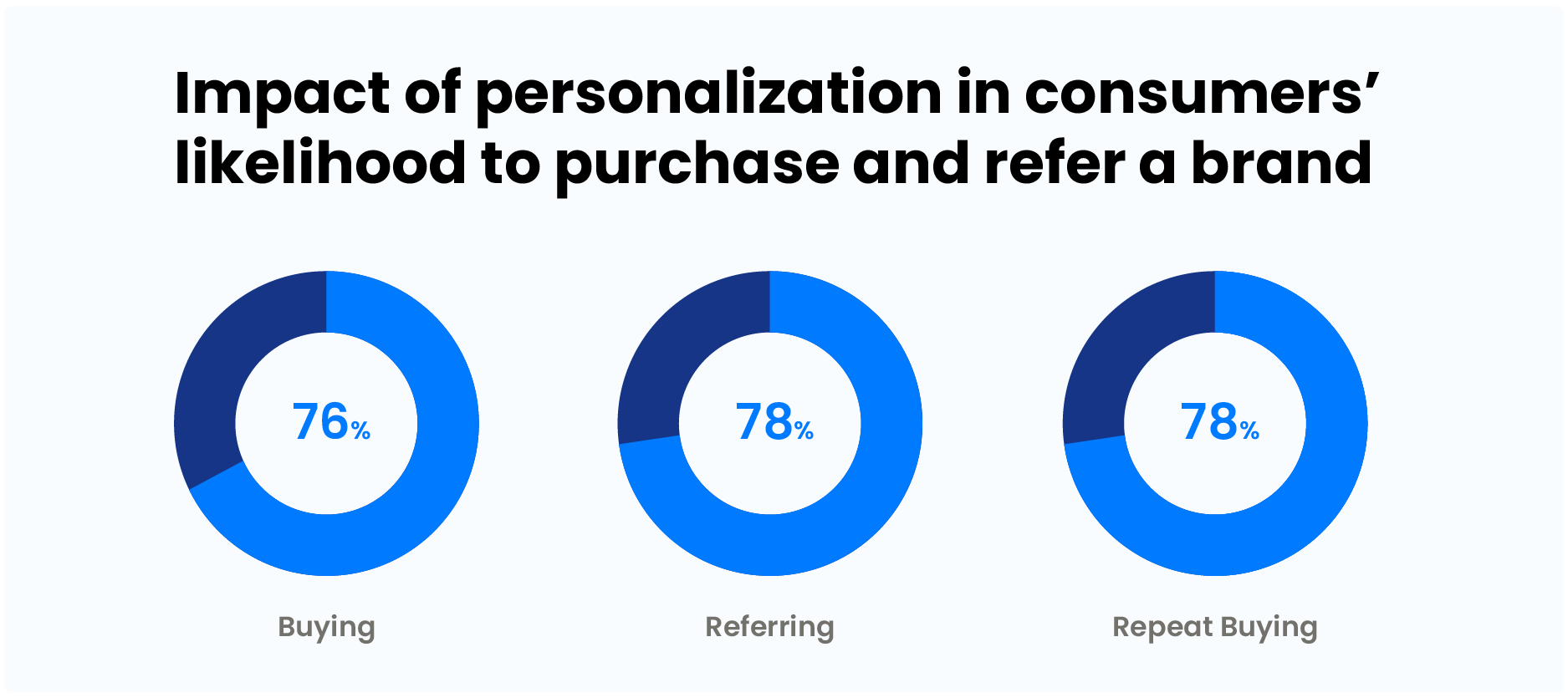
According to a McKinsey survey, 72% of consumers expect brands to recognize them as individuals and know their interests. And they want brands to demonstrate this by:
- Meeting them where they are
- Knowing their taste
- Offering something just for them
- Checking in with them
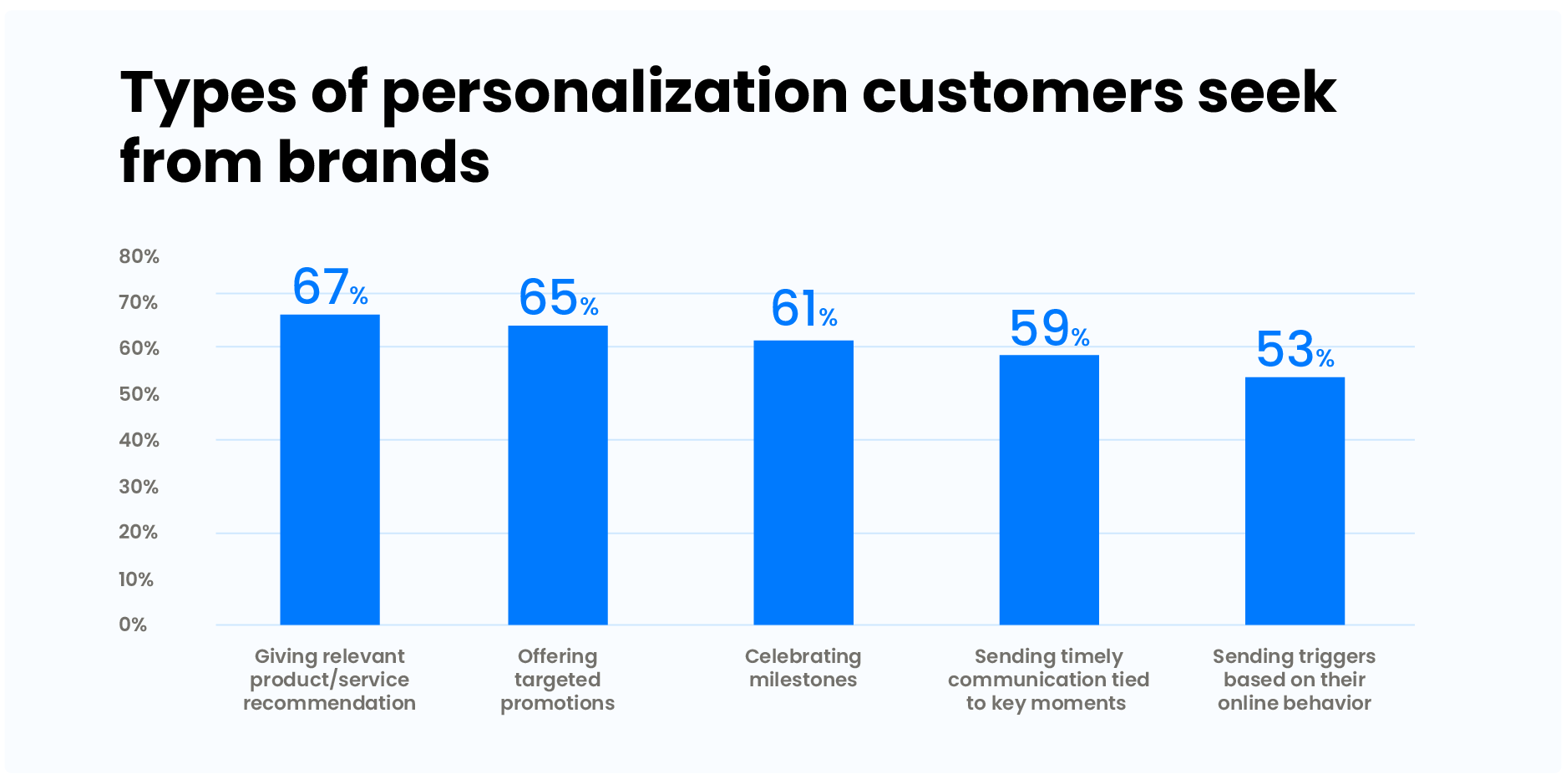
Online shopping platforms, such as Amazon, recommend products based on past purchases. However, Amazon has a sophisticated IT infrastructure, and most brands cannot afford that.
However, brands can simply ask the customer for their details. For example, Birchbox, a New York City-based cosmetics subscription service, asks customers about their skin and hair type before starting the journey.
You can also gather feedback and use your CRM software to personalize the customer journey. Surveys and polls are a great way to ask the customer what they are looking for.
3. Create content based on customer data
Software platforms often create customer experiences based on the time spent with the brand. A famous example is Spotify Wrapped, where Spotify shows the customer’s listening history and how they stack up against others for any given year.
Well, this is not the only one. Spotify’s “Blend” is also an impressive example of a customer engagement strategy, where the platform can generate a shared playlist from your and your friend’s liked songs.
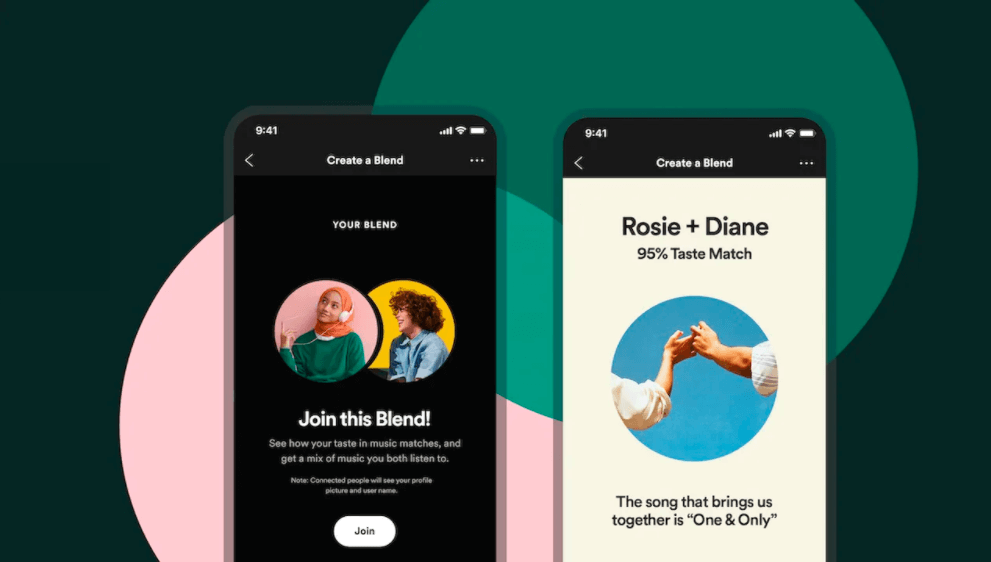
Strava also provides a similar experience called “Your Year in Sports.”
This customer engagement experience allows others to experience the brand and even encourages the user to spend more time with the brand.
4. Social media contests
Social Media contests are a great way to actively engage with customers.
For example, Samsung promotes their community platform by hosting photo contests that can be shared across multiple platforms. Brands such as Apple, Canon, Nikon, and others have also hosted photo contests.
You can pair these contests with giveaways to drive in more engagement.
5. Conversational marketing
Conversational marketing is a method of engaging with your audience and converting leads via dialogue-driven activities.
Sticking to your app or a website is not mandatory for this type of customer engagement strategy.
Take, for example, Whole Foods, an American multinational supermarket chain headquartered in Austin, Texas. While shopping for recipes, the user does not need to download the Whole Foods app. They can directly contact the brand page using Facebook Messenger. Based on the customer’s responses, the chatbot can suggest recipes. Interestingly, it also understands emojis and responds accordingly.
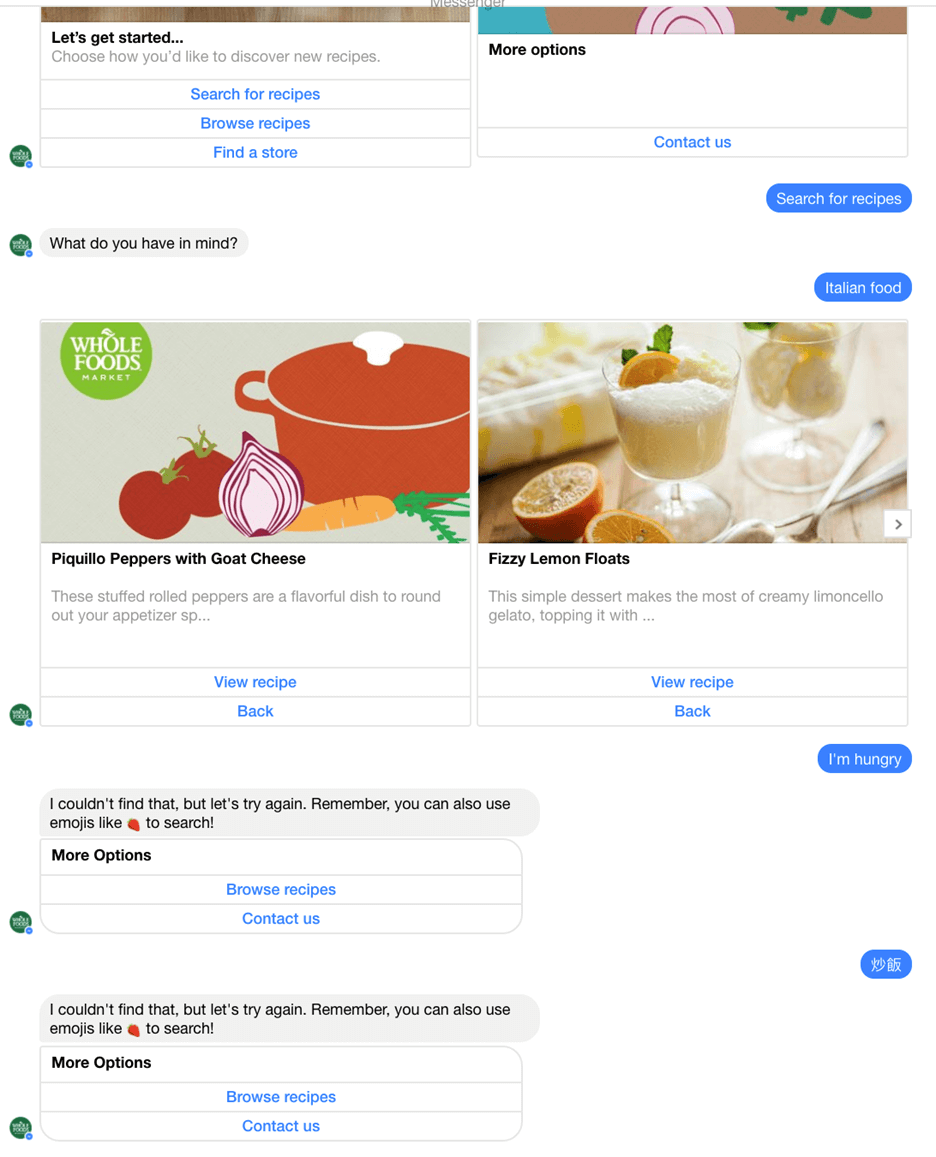
Conversational marketing makes the customer feel more engaged as it’s similar to talking to a human. More than 40% of customer interactions will be AI-enabled interactions by 2023.
6. Create something customer-centric
“At a fundamental level, you can only attract, engage, and retain customers if you show them that you care about what they want. Businesses must invest in initiatives that align with their customer’s interests.”
Adhithya Kumar K S
Associate Manager – Presales, LeadSquared
Do you remember the “Share A Coke” campaign?
It was one of the best engagement campaigns ever made.
Coca-Cola used custom packing systems to create bottles with common names on them. They also removed the brand logo. It made people talk a lot more about the brand – people took photos of bottles with their names and shared them on social media.
The campaign has made history in the world of marketing and advertisement.
But why do you think the campaign was successful?
Well, you guessed it.
For once, a brand did not speak about itself but its customers. And hence the traction.
7. Invest in mobile experiences
For brands trying to reach out to younger customers, mobile experiences should be a key area of focus. While social media and online presence are necessary, create apps and other mobile experiences that enable customers to engage effortlessly with the brand.
It applies especially to e-commerce or mobile commerce apps. If you allow users to place an order from your app, you should be able to address their grievances through the app.
8. Encourage loyalty
“If you treat the customer right, they’re bound to be the next flagbearer for your business!”
David Anand
Technical Consultant, CM.com
Rewarding loyalty is one of the best ways to keep old customers engaged. Loyalty programs, rewards, and discounts are timeless strategies. You can reward customers for loyalty by giving them discounts on future purchases or freebies.
Here’s an example of Samsung Pay doing it right.
Samsung Pay has an extensive user base in US and Canada. In India, however, the UPI-backed payment service loses out to giants such as PayTM and PhonePe. While other payment platforms provide coupons and discounts randomly, Samsung Pay gives assured points for every transaction.
Users can redeem points for gift cards on several other platforms. It gives the user a lot more freedom on how they want to use their reward points. Because of this approach, Samsung Pay’s net transaction volume increased by over 1,000 million INR in 2022, making it one of the fastest-growing platforms.
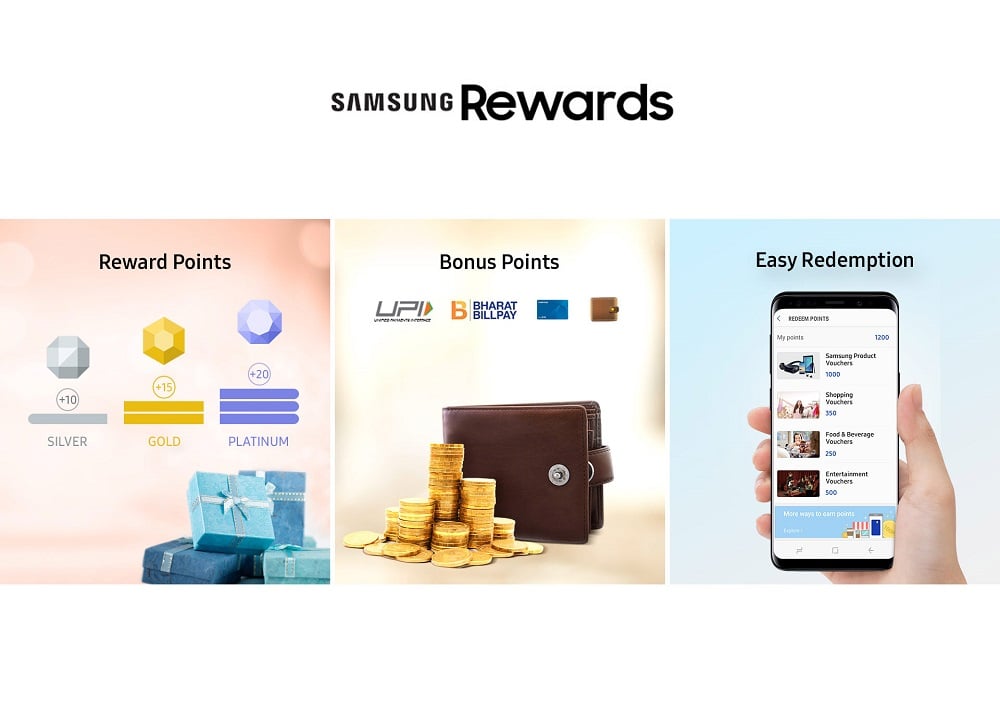
Another customer engagement example that rewards loyalty is that of Starbucks.
Starbucks rewards loyal customers via their Starbucks Reserve Roastery and Tasting Room. It allows customers to chat with coffee experts and watch coffee being brewed from fresh beans.
The sensory experience is something new for customers. It also gives them a sneak peek into how their favorite brand manufactures coffee. This program builds a relationship with customers that is simply beyond their morning coffee.
9. Form a community
What is a community?
A group of people living in a certain place or sharing common interests, right?
Create a community or group where people (your customers) can collaborate and engage in discussions.
It may not be a new strategy, but it always works. We have seen many popular book clubs, health communities, meet-up groups, etc. being successful in customer engagement.
In fact, new-age technology companies like Tesla are also onboard with the idea of engaging customers and making them their brand advocates.
Check out Tesla’s customer engagement page where they update customers with upcoming events, campaigns, and more.
10. Offline customer engagement activities: Meet customers where they are
You cannot always find your customers online—some spend a lot of time disconnected from the internet. Therefore, you will need to create your engagement campaigns accordingly.
For example, you can send holiday cards or simply give a phone call on a birthday or anniversary. While this seems old-fashioned, it also shows that the brand cares for you.
You can also create engagement campaigns using murals, using QR codes that people will come across during commutes, or even on TV ads.
11. Support a cause
Millennials and Gen Zs gave more than any other generation during the pandemic. It shows the economic power and generosity of this group of fintech consumers.
Also, these generations are more likely to engage with brands that share the same values.
Therefore, if you care for a cause, let your consumers know.
For example, Lemonade, the New York-based digital insurer, which targets the younger generation, defines its philanthropic process on its website.)
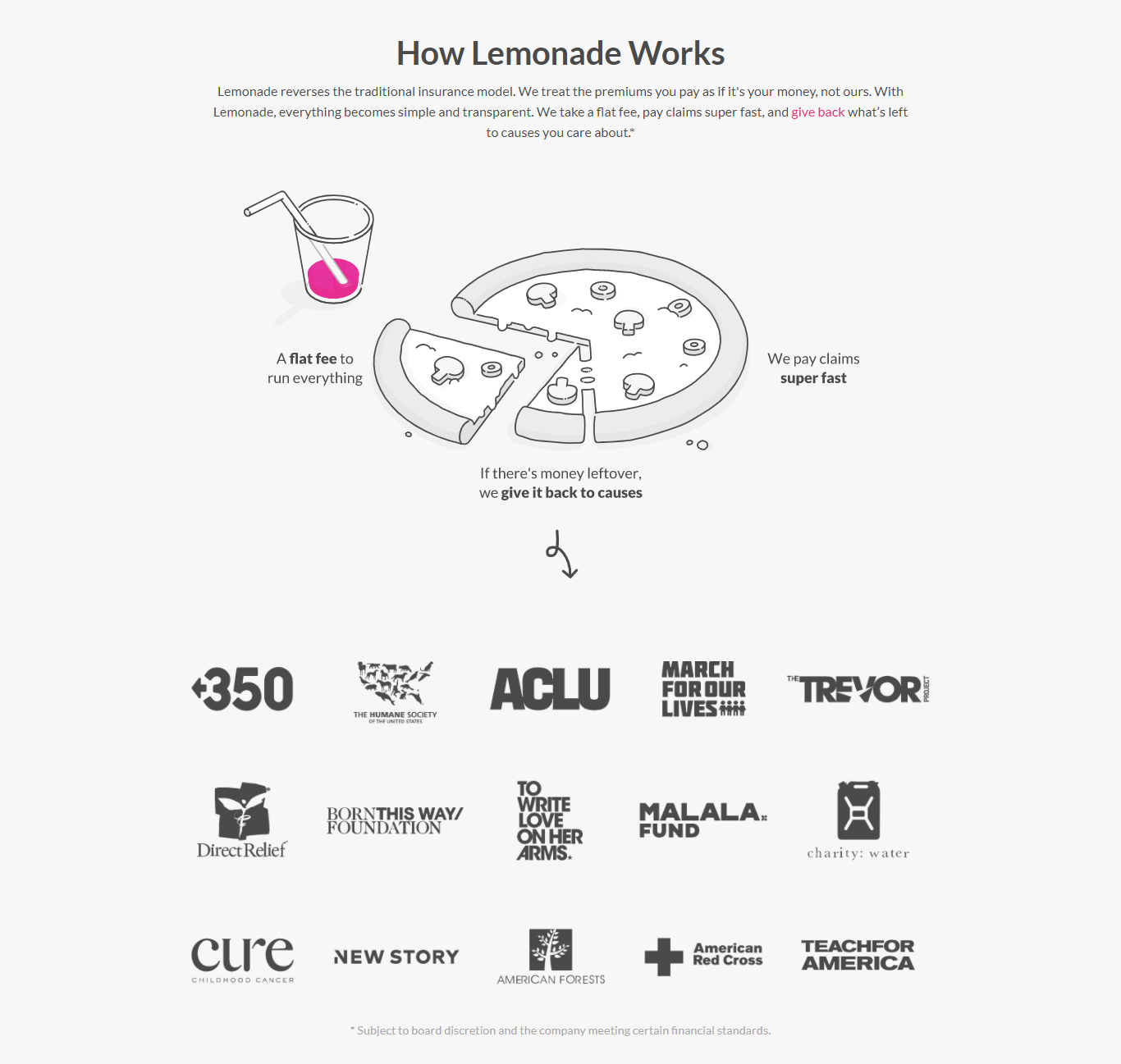
You can also try this customer engagement strategy while taking surveys or feedback. You can give an option to redeem a voucher or donate to a cause.
12. Support your people
We are all aware of the Better.com layoffs story now.
While the company’s unanticipated move has invited criticism on the internet, many other companies are trying to support the workforce by offering them employment.
Contrary to such a disastrous move, Gravity Payments, a Seattle, Washington-based financial services company, shares a different story.
Dan Price, the CEO of the company, decided to implement the minimum annual salary of $70k for its employees solely to improve employee satisfaction and improve their quality of life. Surprisingly, this step also drastically improved their customer engagement.
Six months after this announcement in 2015, their revenue started growing at double the previous rate. Also, their customer retention rose from 91% to 95% in the second quarter. When employees are treated better, they work better—helping the company grow faster. As a business, your dealers and third-party vendors are a part of the process as well. While they may not be your employees, you still need to improve their experience with your brand. Everyone in the process needs to be engaged for it to funnel down to customers.
“The leading players have created their brand value by prioritizing service and experience. And this experience needs to extend to your brokers, distributors, and dealers to eventually resonate with your buyers.”
Adhithya Kumar K S
Associate Manager – Presales, LeadSquared
So, there are some of the successful customer engagement strategies you can try for your brand. However, before everything else, ensure you have a process in place.
A 6-Step Customer Engagement Strategy for Success
To create a sustainable customer engagement strategy, here are a few things that you need to do.
1. Create SMART goals
SMART stands for Specific, Measurable, Achievable, Realistic, and Timely. Make sure your customer engagement plan is based on SMART goals.
To check the effectiveness of your efforts, ask yourself:
- How does the increased customer engagement rate benefit you?
- Why would the customer want to engage with your brand?
It is crucial to figure out how and why the engagement will take place. This information will help create functional and sustainable strategies.
2. Identify customer touchpoints for engagement
Each brand has its idea of customer engagement. For instance, a brand may choose to do a marketing campaign to attract new prospects and engage with them. Alternatively, another brand can engage with customers who have already made the purchase.
“Communication isn’t just a part of the sales cycle; it must be consistent! Businesses need to use the same channel to interact with customers, even after the sale is complete. Be proactive and open to all their questions on their preferred channel.”
David Anand
Technical Consultant, CM.com
You can engage with your customer in multiple ways, at different points in the customer lifecycle, and over multiple platforms. It’s not mandatory to be present everywhere. However, identify the customer engagement platforms where your customers are most active and engage with them on those sites.
3. Plan incentives for engaged customers
There is no free lunch in this world. Your customers also expect something valuable from the engagement. It can be entertainment, knowledge, or simply monetary gains.
Planning incentives for engaged customers will definitely help you in the long run.
Here are some ideas to incentivize customers for being with you:
- Direct discounts on the products they like
- Free samples
- Free memberships
- Offers and discounts on partner products
- Gift cards
- Charitable donations
4. Cross-functional team collaborations
Communication between teams is essential to understand who is working with which customer. Cross-functional communication ensures that the brand stays in the loop. Sales reps and marketing teams don’t follow the same customer engagement tactics. But, just knowing what each team does helps businesses develop relevant strategies without overwhelming the customer.
5. Gather feedback and update your strategy
Once you start a customer engagement campaign, start tracking the customer engagement metrics crucial for your business. Take feedback from customers, as well as internal teams dealing with customers.
Do not wait for an entire financial year to update the strategy. Based on the feedback and metrics, adjust your campaign strategy frequently.
6. Finally, use a CRM software to track interactions with your customers—at an individual level
To get a 360-degree view of how your customers interact with your brand, I suggest using a CRM. It helps you track the activities of every customer and engage with them accordingly. While there are many customer engagement tools available, a CRM is the most comprehensive solution that can be easily integrated with your current sales and marketing process.
For example, if a customer is checking out your newly launched sports shoe range, you can trigger an email or SMS with a discount coupon. Such prompt gestures increase the chances of conversions.
Here’s how a CRM can help you improve customer engagement:
- Discover touchpoints and create trigger-based campaigns along those touchpoints
- Track customer interactions
- Identify opportunities by listening to the up-selling and cross-selling signals
- Automate your nurturing campaigns
- Segment buyers based on several parameters—location, product preferences, etc.—and send targeted engagement campaigns.
A Case Study: How Propcrown Improved Customer Engagement with Automation?
Propcrown Global is a real estate boutique brokerage and advisory firm. They follow a consultative selling approach, where they guide buyers to shortlist properties according to their requirements.
The challenge:
Propcrown was losing potential customers to competitors because of missed follow-ups and slow responses.
The apparent reason for this loss was inefficient customer engagement, which is necessary for the businesses like Real Estate.
The solution:
The sales cycle in real estate easily takes about 2-3 months as people visit many websites and consult several brokers before finally deciding anything. Propcrown also wanted to update buyers on the upcoming projects that would be good for them.
LeadSquared helped Propcrown create automated buyer engagement workflows. It allows drafting, scheduling, and adding SMS and email communication to the automation workflows. The automation ensures that the buyer is instantly nurtured at every stage—welcome emails, follow-ups, and updates.
“To put it simply, LeadSquared has made all our operations a lot easier. With LeadSquared, we have improved communications with potential buyers, and the automation has reduced response time. It enables us to have an edge over our competitors and offer the best services to our buyers.”
Shikhar Verma, Director, Propcrown
Do you want to see LeadSquared’s engagement workflow automation and explore how it fits in your use cases? Get in touch!
FAQs
Customer engagement helps at each stage of the customer’s journey. It covers each stage from acquisition to retention:
1. Discovery: Customer engagement at this stage makes your brand discoverable.
2. Consideration: Beat your competitors with your engaging content and interactions.
3. Buying: Support and service teams can boost client engagement at this stage.
4. Loyalty: Collect feedback and schedule frequent check-ins to minimize churn.
5. Advocacy: Your customers turn into your cheerleaders! Only if you have a spot-on customer engagement strategy.
The most important customer engagement metrics are:
1. Net promoter score (NPS)
2. Customer satisfaction score (CSAT)
3. Customer lifetime value (CLV)
4. Churn rate
5. User activity
Customer engagement marketing extends your relationship with customers beyond deals and conversions. It includes hosting relevant sessions for customers, addressing their concerns, and frequently sharing content, such as blogs or product updates, with them.








